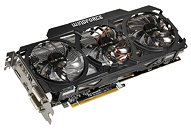I want it, and yet I don't. It's to much power for 1080p, and it consumes roughly twice the power of my 7870. If I have no patience then I might spend some Christmas dough on it, otherwise I can wait till something 30% more powerful with equal consumption comes around.
Why must you reinforce this perfectly reasonable thought into my brain?
I don't quite get why they went with 5ghz memory when you can buy 7ghz stuff. Maybe some SOC-like cards are to come ?
XFX did something like that some time back and got into a hell of a lot of trouble. Spec is spec...not only because skus are teamed with certain ram for performance parity while performing within a certain tdp/voltage (and 5/7ghz are not remotely close, especially on a 512-bit bus and 4GB), but also many times market segmentation. They don't want today's (7870 or 680) product beating tomorrow's (270x or 770)...even if they are the same chip.
As for why it's not realistic, Hawaii is built on the sound principle more slower memory controllers (and ram) consume a disproportionate less amount of die space and power than less controllers that run proportionally faster within a certain speed threshold. This therefore makes a slower/wide bus a good design decision as pad space allows in accordance to die space needed for the rest of a design. It is clearly shown to be the case (and methodology) in many products throughout ati's history...the most blatant comparison is Pitciarn vs GK106, which are the same die size but Pitcairn's spec is much more thoughtful (Again, designed to mesh with ~1170mhz per avg 28nm abilities and at least ~5300mhz using cheap Elpida ram). I think it's fairly safe to assume Hawaii uses Pitcairn's memory controller...it is more-or-less 2x Pitcairn + 4 CUs + dsp engine/bridgeless crossfire. On 40nm, amd mentioned that the controller on Cypress (4800mhz) was twice as large as the 4200mhz controller on redwood. When adjusted for the roughly 30% power/performance improvement of 28nm, you essentially get the Hawaii/pitcairn/etc and Tahiti/Bonaire controllers respectfully. It could conceivably even be argued Cayman may have been a trial-run for the former...but at any rate, faster memory would not do them any good without a faster memory controller. A faster memory controller would do them no good unless they had a larger power envelope. I imagine they were hoping for something like 1150/5700+ (overclocking is included in design obviously) for Hawaii...the same approx clocks you'll find on a 270x...which again fits with the controller, the ram, and scaling up to around the the norm for 28nm without absurd voltage, especially on large designs.


















